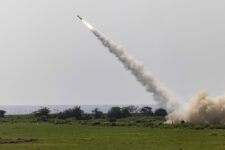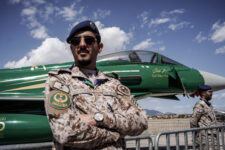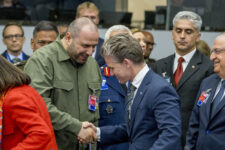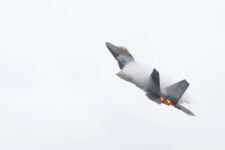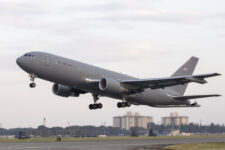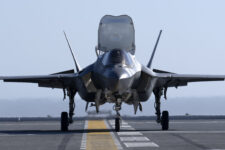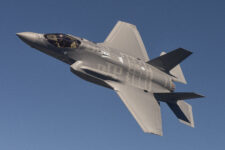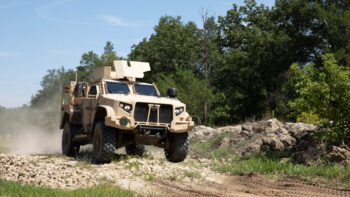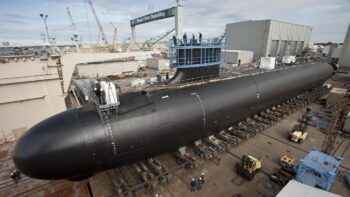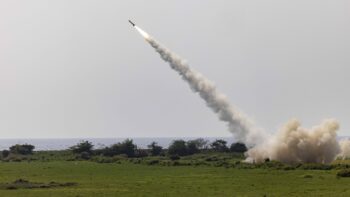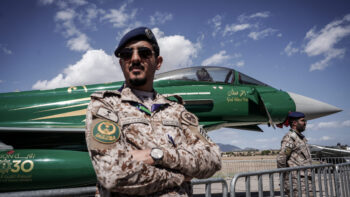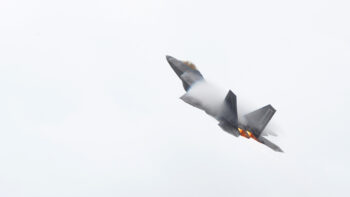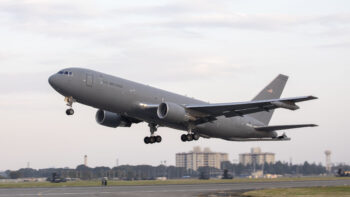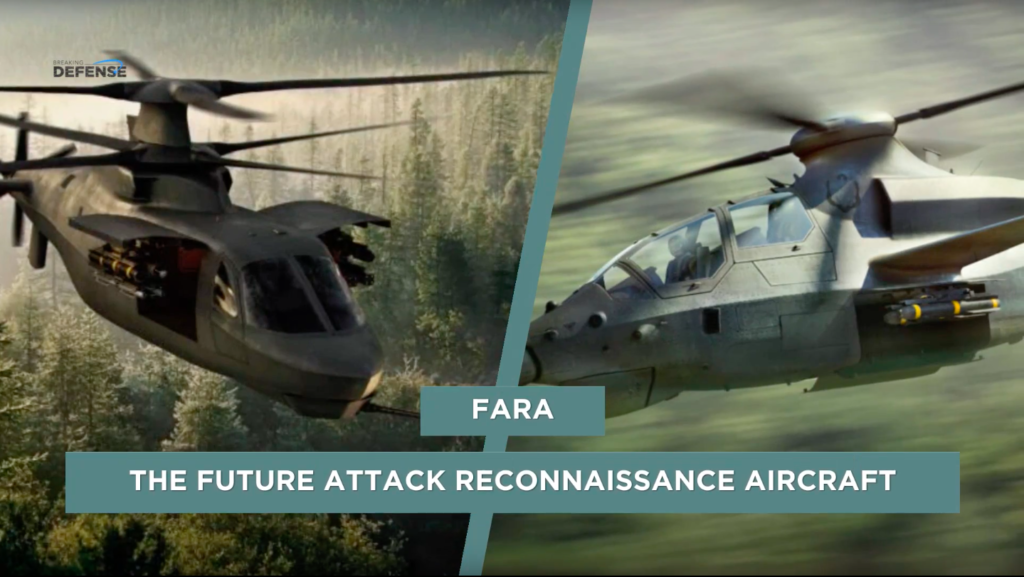
The Sikorsky Raider-X (left) and the Bell 360 Invictus (right)
WASHINGTON: The year is 2030, and an Army scout aircraft streaks above the treetops at 200 miles an hour.
At speeds no conventional helicopter could reach, advanced sensors and automation help the human pilots skim over obstacles while staying under radar. Wireless networks link the manned craft to a swarm of unmanned ones: mini-drones to scout ahead, big flying “mules” to haul high-powered jamming pods and racks of missiles. Miles overhead, satellites spot enemy anti-aircraft batteries and warn the pilots to evade, then transmit target coordinates to long-range missile batteries that blast a path for the aircraft to advance.
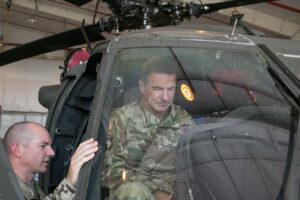
Gen. James McConville checks out the upgraded cockpit of the new UH-60V “Victor” model, which will be mainly used by the National Guard.
That’s the vision for Army aviation in future wars, as laid out for us in interviews with senior pilots — including the Chief of Staff.
Can Army aircraft, flying lower and slower than stealthy jets, really stay survivable and relevant in the face of high-tech anti-aircraft defenses? Absolutely, Gen. James McConville told me ahead of the annual Association of the US Army conference.
“The future battlefield will be much more lethal, much more dangerous for aircraft,” the Chief of Staff told me. “We’re going to have to be concerned about multiple air defense systems, [but] there’s multiple things you can do to protect the aircraft.”
[Click here for more from our exclusive interview with Gen. McConville]

Brig. Gen. AlAan Pepin
“The reality is no technology is going to protect you alone,” said Brig. Gen. Allan Pepin, head of US Army Special Operations Aviation Command, which has pioneered low-altitude tactics to evade detection. But what if you take those tactics and add multiple new technologies, from the blistering 200+ mph speeds already achieved by experimental Future Vertical Lift aircraft, to long-range precision weapons, to the networked teams of manned and unmanned aircraft flight-tested at China Lake and Yuma Proving Ground? Then you get a future force that can win through – or, at least, it does in Army wargames and simulations.
The concept is what the Army, with its typical awkward jargon, is calling the “lower-tier air domain.” The idea is to fly the seam between earth and sky: high enough to race over the rivers and rough terrain that slow down ground troops, low enough to avoid radar-guided missiles that threaten jets. In this in-between realm, the generals told us, Army aviation can not only survive, but make a unique contribution to victory that neither high-altitude airpower nor surface forces can replicate.
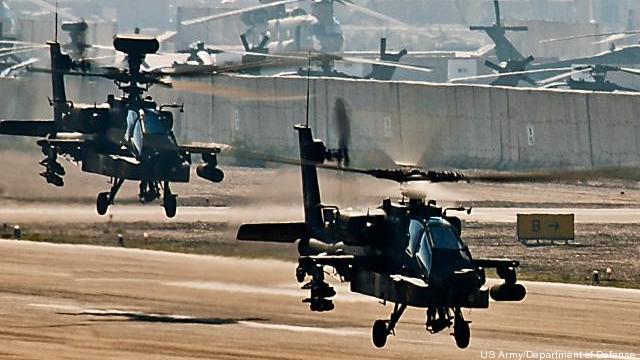
AH-64 Apaches
From High To Low
Some 17 years ago, during the invasion of Iraq, 32 AH-64 Apache gunships on a long-range raid flew low past the city of Najaf. The heavily armed and armored attack helicopters, pride of Army aviation, got shot up so badly that one went down – its crew were captured by the Iraqis – and the rest turned back. After that, the threat of small-arms fire, combined with the extreme altitudes of eastern Afghanistan, drove a generation of Army aviators to focus on training, tactics, and technologies for flying high.
But unlike jet aircraft, helicopters can’t fly high enough to escape surface-to-air missiles. Against a foe more sophisticated than the Taliban – like Russia, China, North Korea, or Iran – their best chance of survival is to fly low, where hills, forests, and buildings hide them from enemy radar. That requires an entirely different set of training, tactics, and technologies, which the Army is now in the throes of developing.
“You fly the speed, you fly the altitude, and you use the tactics, depending on the enemy you face,” McConville told me. “When you look at the threat, if it’s small arms, then helicopters may fly higher…. If it’s a radar threat, you may fly lower to take advantage of the terrain.”

Gen. David Francis
“We’re in the midst of training our aviation formations differently to operate versus peer and near-peer adversaries,” said Maj. Gen. David Francis, who commands the aviation training “schoolhouse” at Fort Rucker, Ala. “What we have to do is develop our ability to fly that low level [and] the tactics, techniques and procedures that allow us to fight decisively in large-scale combat operations.” That includes a new block of instruction on low-altitude tactics and updated emergency procedures for low altitudes where pilots have much less time to react to a problem before they impact the ground.
“Some of the best techniques for these altitudes … come from our special ops aviation forces,” Francis added.
“Since the formation of USASOC after the Iran hostage failure [in 1980], we’ve stayed focused on flying low to mitigate risk against enemy early warning systems and air defense,” Pepin said, even though that raises the risk of hitting obstacles and small-arms fire. “We do that routinely…against real-world threat systems.”
What’s more, Pepin added, while special ops aviators remained focused on counter-terrorism when they deploy abroad, “in our home station training, we are 100 percent focused on the high-end, large scale combat operations.”
FVL: Go Fast
Taking cover from anti-aircraft weapons amidst low-altitude radar clutter is central to the Army’s plan for Future Vertical Lift, a flying “ecosystem” of interconnected manned and unmanned aircraft. FVL pilots will use the terrain for self-protection, on top of jammers, decoys, and other technological countermeasures, said Brig. Gen. Walter Rugen, the FVL director at Army Futures Command. “We can use tactics, techniques and procedures to a far greater extent than technology that other, higher fliers have to use,” he told me.
That doesn’t mean FVL is low-tech. To the contrary, the novel aircraft designs that Lockheed Martin (bolstered by its purchase of Sikorsky) and Bell are now developing – tiltrotors, compound helicopters with pusher propellers, choppers with wings – offer speed and range that conventional helicopters cannot match.
Even with extensive automation in the cockpit – the goal is for FVL to fly itself in some conditions – it’ll take intense training to teach humans to maneuver around obstacles at these velocities. “We’re going to have to train crew members to fly at those speeds [and] overhaul our training methodology,” Pepin said. “We don’t want to have an aircraft that can fly twice as fast but we’re flying at the old speed.”
You also need sensors to spot obstacles at greater distances while there’s still time to react. “The human eye can only see so much,” he said: To survive at FVL speeds, “we have to start seeing things further out.”
The human brain can also only handle so much complexity. “We’re very focused on offloading the cognition requirements of the cockpit,” Rugen told me, “automating what we already know the machine may do better,” like preventing high-speed collisions.
“I don’t want to oversell what we’ve already demonstrated in experimentation,” he said, “but we’ve shown our unmanned systems [can] know where the other manned and unmanned aircraft are and deconflict around them.” That kind of automated collaboration is central to Future Vertical Lift.
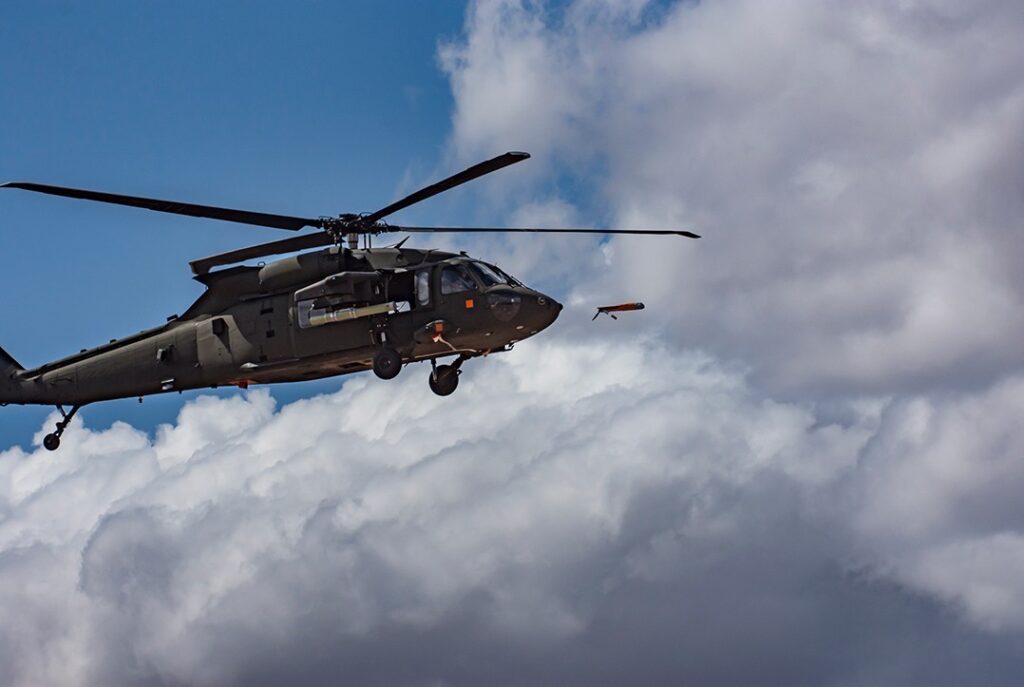
A UH-60 Black Hawk launches an ALTIUS mini-drone at Yuma Proving Ground.
Into the Swarm
The manned Future Vertical Lift aircraft won’t rely solely on their onboard sensors to spot threats and obstacles. Instead, they’ll pull data from drones, satellites, and other sensors to vastly extend the pilots’ perception of the war zone.
This digital revolution traces its roots back to Iraq, Gen. McConville told me. After growing up wrestling with paper maps and a flashlight during night missions, he said, “having Global Positioning Satellites [updating] moving map displays in the cockpit just gave us this incredible speed to get the target.” In battles like Sadr City, he went on, “we could have our attack helicopters stand off,” out of the enemy’s sight, while drones with laser designated pinpointed targets for precision strikes.
Against high-tech opponents, however, you can’t rely on any single technology because the enemy may find a counter. So Future Vertical Lift envisions a mesh network that gives manned and unmanned aircraft multiple pathways to connect even when a given link is jammed. That will allow pilots access to a wide range of options, not just the equipment on their own aircraft.

Brig. Gen. Walter Rugen
The FVL scout, the Future Attack Reconnaissance Aircraft, will be armed with a new 20mm cannon now in testing and a Modular Effects Launcher capable of firing either long-range missiles or mini-drones carrying sensors, jammers, communications relays, and other specialized payloads.
Those mini-drones, called Air-Launched Effects, should be numerous and expendable enough to “flood the zone,” Brig Gen. Rugen said: In the recent Project Convergence exercise in the Yuma Desert, the Army kept eight ALE surrogates in the air at once, sharing data across a 40-mile front.
Larger drones will act as “mules,” Rugen said, carrying payloads too big for ALE: long-range jammers, racks of missiles, and even additional ALEs. (Heavily modified MQ-1C Grey Eagles played this role in recent experiments). Pilots can call in the mule drones to stage electronic or physical attacks so manned aircraft don’t expose themselves to detection by emitting a jamming signal or launching a missile.
So, unlike the heavily armed Apache, “FARA doesn’t have to carry everything, [because] it’s going to outsource the lethality,” Rugen said. “We want to use other people’s stuff.”
In fact, the most powerful punches that future pilots can unleash won’t come from an aircraft at all. They’ll be long-range strikes by ground-based artillery and missile launchers now in development, which the Army sees as blasting paths through enemy defenses for airpower to advance.
In this fall’s Project Convergence exercise, Rugen said, ALE mini-drones helped spot a target for a 36-mile cannon shot. Next year’s Project Convergence should feature a 300-plus-mile shot from a prototype Precision Strike Missile. Hypersonic weapons set to entire service in 2023 will fly thousands of miles. And Army aviation will share data with other services’ long-range weapons as well, from F-35 fighters to Navy Tomahawks.
So, helicopters or tiltrotors may spot the target, but that doesn’t mean they have to be the ones that shoot it. “In this joint environment,” Pepin said, “we don’t really care whether something comes off a fixed-wing platform, an unmanned platform or ground platform.” What matters is whatever kills the target – and keeps US troops alive.
